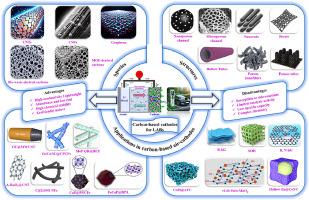A Comprehensive Review of Carbon-Based Air Cathode Materials for Advanced non‒aqueous Lithium‒Air Batteries
IF 18.9
1区 材料科学
Q1 CHEMISTRY, PHYSICAL
引用次数: 0
Abstract
Lithium‒air batteries (LABs) present a promising solution for future energy storage due to their exceptional energy density and potential to address imminent energy and environmental challenges. The complicated generation and breakdown of Li2O2 at the air‒cathode is the main cause of the durability and stability problems that LABs encounter. These problems are not merely related to low catalytic efficiency; instead, problems are made worse by restricted charge/discharge reversibility along with side‒product generation in open‒air. Furthermore, the function of solid‒phase electrocatalysts is still controversial, particularly when Li2O2 generation is involved. This makes the hunt for efficient air‒cathode materials more challenging. Since their inception in 1996, carbon has been crucial in advancing LAB technology, enhancing our understanding of its mechanisms and applications. This review examines advances in carbon materials and chemistry for LABs, focusing on structural characteristics, electrochemical behavior, and mechanistic insights. Air‒cathode materials are categorized into carbon nanotubes (CNTs), carbon nanofibers (CNFs), graphene, bio‒waste‒derived carbons, and metal‒organic frameworks (MOFs)‒derived carbons. Additionally, the review evaluates the design, synthesis strategies, and electrochemical performance of these carbon‒based air‒cathode materials. It also explores oxygen‒selective membranes (OSMs) as a potential solution to mitigate the adverse effects of H2O and CO2 in ambient air, which lead to the formation of Li2O2 and reactions with the electrolyte and Li anode in open‒air systems. In conclusion, this review addresses the current challenges faced by LABs and highlights the potential for further research and development in this field.

用于先进非水锂离子空气电池的碳基空气负极材料综述
锂空气电池(LABs)以其超高的能量密度和解决迫在眉睫的能源和环境挑战的潜力,为未来的能源存储提供了一种前景广阔的解决方案。锂-空气电池遇到的耐久性和稳定性问题的主要原因是空气阴极中 Li2O2 复杂的生成和分解过程。这些问题不仅仅与催化效率低有关;相反,在露天环境下,充放电可逆性受限以及副产品的产生会使问题更加严重。此外,固相电催化剂的功能仍存在争议,尤其是在涉及锂2O2 生成时。这使得寻找高效空气阴极材料的工作更具挑战性。自 1996 年问世以来,碳一直是推动锂电池技术发展的关键,并加深了我们对其机理和应用的理解。本综述探讨了用于 LAB 的碳材料和化学方面的进展,重点关注结构特点、电化学行为和机理认识。空气阴极材料分为碳纳米管 (CNT)、碳纳米纤维 (CNF)、石墨烯、生物废料衍生碳和金属有机框架 (MOF) 衍生碳。此外,综述还评估了这些碳基空气阴极材料的设计、合成策略和电化学性能。本综述还探讨了氧选择膜 (OSM) 作为一种潜在的解决方案,可用于减轻环境空气中 H2O 和 CO2 的不利影响,这些不利影响会导致形成 Li2O2,并与露天系统中的电解质和锂阳极发生反应。总之,本综述探讨了锂电池目前面临的挑战,并强调了该领域进一步研究和开发的潜力。
本文章由计算机程序翻译,如有差异,请以英文原文为准。
求助全文
约1分钟内获得全文
求助全文
来源期刊

Energy Storage Materials
Materials Science-General Materials Science
CiteScore
33.00
自引率
5.90%
发文量
652
审稿时长
27 days
期刊介绍:
Energy Storage Materials is a global interdisciplinary journal dedicated to sharing scientific and technological advancements in materials and devices for advanced energy storage and related energy conversion, such as in metal-O2 batteries. The journal features comprehensive research articles, including full papers and short communications, as well as authoritative feature articles and reviews by leading experts in the field.
Energy Storage Materials covers a wide range of topics, including the synthesis, fabrication, structure, properties, performance, and technological applications of energy storage materials. Additionally, the journal explores strategies, policies, and developments in the field of energy storage materials and devices for sustainable energy.
Published papers are selected based on their scientific and technological significance, their ability to provide valuable new knowledge, and their relevance to the international research community.
 求助内容:
求助内容: 应助结果提醒方式:
应助结果提醒方式:


